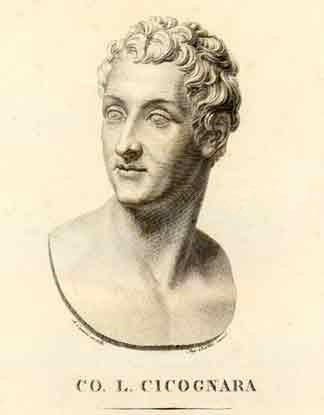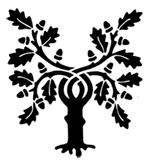Count Leopoldo Cicognara (1767-1834) was a young politican involved in greater difficulties, first prisoned and then released, art and book collector, director of the just founded Academy of Fine Arts in Venice from 1808-1827 and founder of a museum. He sold his own library, a collection of ca. 5000 books, to the current pope, who added it en bloc to the Vatican library (compare for a biography the section for Foreign Links).
From his writings the late work Memorie spettanti alla storia della calcografia, 1831 became of importance for Playing Card History. Cicognara presents there six Tarot cards of a complete deck in his possession, of which some have a closer similarity to the socalled Rouen or Leber Tarocchi, a fragmentarious deck with totally 30 extant cards dated at the begin of 16th century. Interestingly both decks have a variation on the suit of batons - it is presented for both decks by an oak-tree. An oak-tree was the heraldic design of the della Rovere shield, the Italian family, which contributed with 2 popes (Sixtus IV 1471-1484 and Julius III. 1503 - 1513) to the reigning heads in late 15th / early 16th Italian renaissance. A special della Rovere deck is in the neighbourhood of decks made for the reigning families in Milan (Sforza-Visconti) and Ferrara (Este) not a surprize, and as some family members were well known for excessive card-playing it even has some logic.

The situation creates an interesting riddle: the small arcana of both decks seem similar, but the trumps seem to have different. Indeed the 2 presented Cicognara trumps (an Apoll and an Amor) have great similarities to trumps of the Bolognese 17th century artist Mitelli.
We will contribute to this theme in near future.
"Our" Leopoldo Cicognara cards shouldn't be confused with the Antonio Cicognara cards (15th century), as they appear in other Tarot history literature, based on the attempt of the same Leopoldo Cicognara in 1831, who presented a theory according which his own 15th century ancestor or relative Antonio Cicognara (well-known miniaturist and painter) produced a Trionfi deck for cardinal Ascanio Sforza in 1484 according to a chronicle of Cremona. A controlling process of the original chronicle gave the result, that it didn't contain the relevant passage (Kaplan Encyclopedia I p. 33). Although this negative result existed, the search for the 15th-century-Cicognara cards didn't stop and also in Kaplan's Encyclopedia I variously the suggestion is presented, that this or that really existing object might be one of the Cicognara cards.
Michael Dummett in his "Game of Tarot" (Appendix) commented the Cicognara case:
|
In Count Leopoldo Cicognara, Memorie spettanti alia Storia della Caliografia, Prato, 1831, p. 16, there is quoted an alleged excerpt from the Chronicle of Cremona by Domenico Bordigallo. The excerpt is in Italian, and states that in the year 1484 the excellent painter Antonio Cicognara (of the same family as the Count) painted uno magnified ma^o de carte dette de' Tarocchi, da me veduto (a magnificent pack of the cards called tarocchi, seen by me) for Cardinal Ascanio Sforza. Count Cicognara says that this passage was communicated to him by Mgr Antonio Dragoni from the schede (notes) of Giacomo Torresino, an eighteenth-century Cremonese antiquarian. On the strength of this passage, numerous art historians have ascribed various hand-painted Tarot cards of the fifteenth century to Antonio Cicognara, including the six cards of the Visconti-Sforza pack that are not by Bembo; but the passage is almost certainly spurious. Any historical document connected with Dragoni is under the gravest suspicion, since he was either a forger or the dupe of forgers, although he was primarily concerned with documents relating to the Dark Ages, of which he made, or manufactured, a large collection. Torresino did indeed compose notes on local history, using a page for each year, and entering quotations relating to that year from various sources; but this work, at any rate in the form in which it survives in the Biblioteca Statale at Cremona, stops before 1484. Bordigallo's Chronicle was written in Latin, and has never been published; the manuscript was located by Signer Marco Santambrogio, of the University of Bologna, in the Biblioteca Treccani in Milan, where, with the kind assistance of Signora Caria Treccani degli Alfieri, he examined it; he found that, while the entry for 1484 does contain a reference to Ascanio Sforza, namely to record that it was in that year that he was created a Cardinal, it mentions neither Antonio Cicognara nor tarocchi. It is conceivable that the quotation was in some later section of Torresino's notes that has since been lost, but from some other source, or that it is in Bordigallo's Chronicle," but under a later year (Ascanio Sforza died in 1505); but the probability is that it is quite inauthentic. In any case, the use of the modern word maw for 'pack' was, so far as I am aware, unknown in fifteenth-century Italian, which uses paro or gioco instead; so, even if the Italian given by Count Cicognara is a translation of some genuine Latin original, the word tarocchi is not likely to have occurred in that original. See M. Dummett, 'A Note on Cicognara', Journal of the Playing-Card Society, vol. II, no. 1, August 1973, pp. 14-17 (original issue), pp. 23-32 (reissue), and 'More about Cicognara', ibid., vol. V, no. 2, pp. 26-34." |
Michael Dummett gives then some critical commentaries to Stuart Kaplan's representations about Cicognara in Encyclopedia of Tarot I, which had appeared 1978 short before his own work "Game of Tarot" (1980). Finally he ends with:
|
"Of course, it is perfectly plausible that Ascanio Sforza should have had some tarocchi made for him. But, ever since 1831, the names of Antonio Cicognara and of Ascanio Sforza have been endlessly cited, in books, articles and museum catalogues, in connection with tarocchi, and it is in my view best to make no further reference to those two individuals until some genuine evidence of such a connection becomes available." |
Following Michael Dummett's advice we have with our 5x14-theory a totally different opinion to the origin of the six additional cards in the Pierpont-Morgan-Bergamo-deck.
Publications:
- Storia delta scultura, Venice, 1813-1818, 3 vols. fol. with 131 plates
- publication on the manufactures and monuments of Venice (2 vols. fol. 1815-20; new edition, 1833-40 with 250 plates
- Catalogo ragionato dei libri d'arte, Pisa, 1821 - catalog of his library
Relevant to playing cards:
- Memorie spettanti alla storia della calcografia, Prato, 1831, now online - see below. However, the edition is disturbed and seems to include no pictures.

Memorie spettanti alla storia della calcografia By Leopoldo Cicognara
Own Links
Foreign Links
|


Rovere heraldic
Link to Portrait of
Francesco Maria Della Rovere
by Raphael (1504)
- with small oak in the background
|


